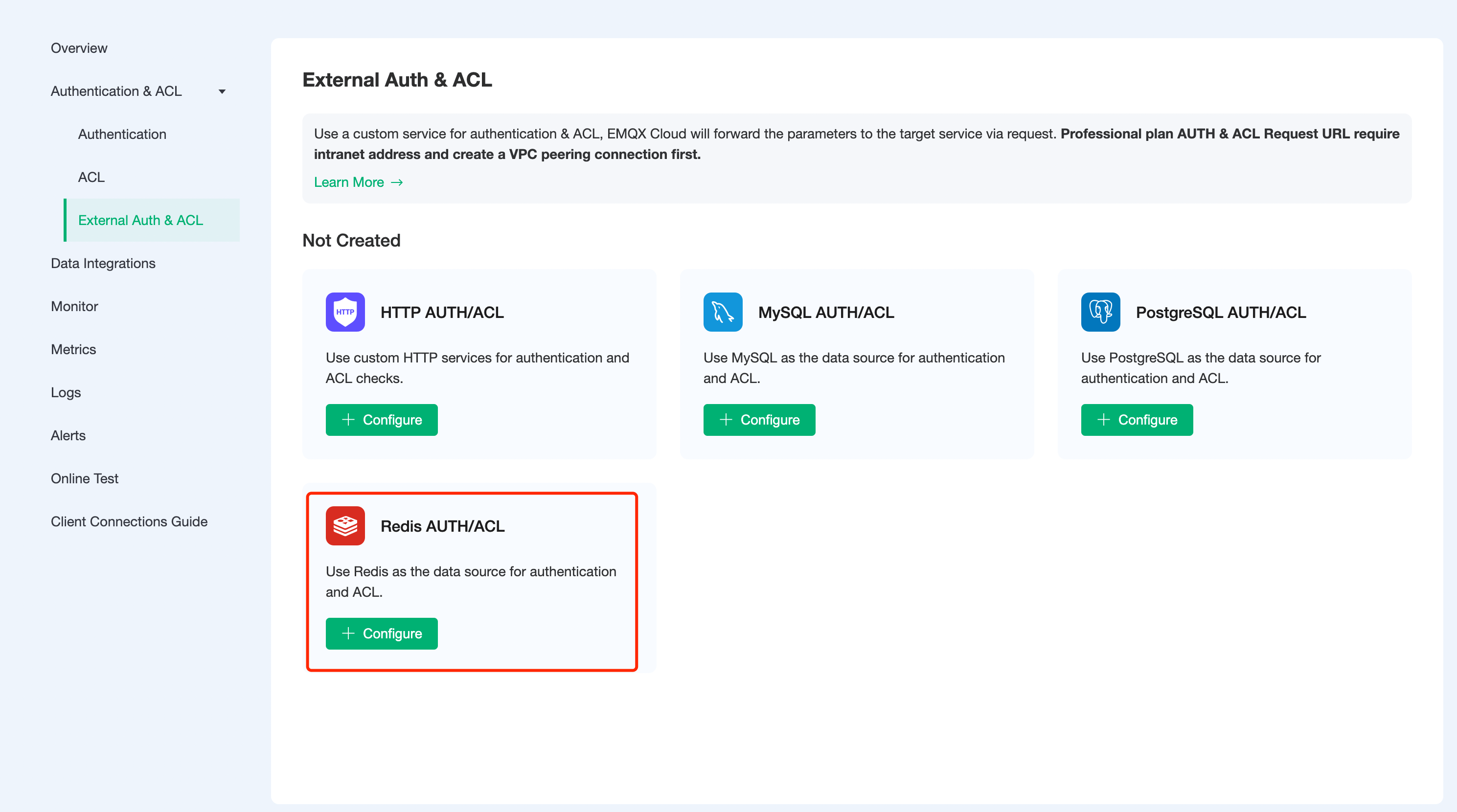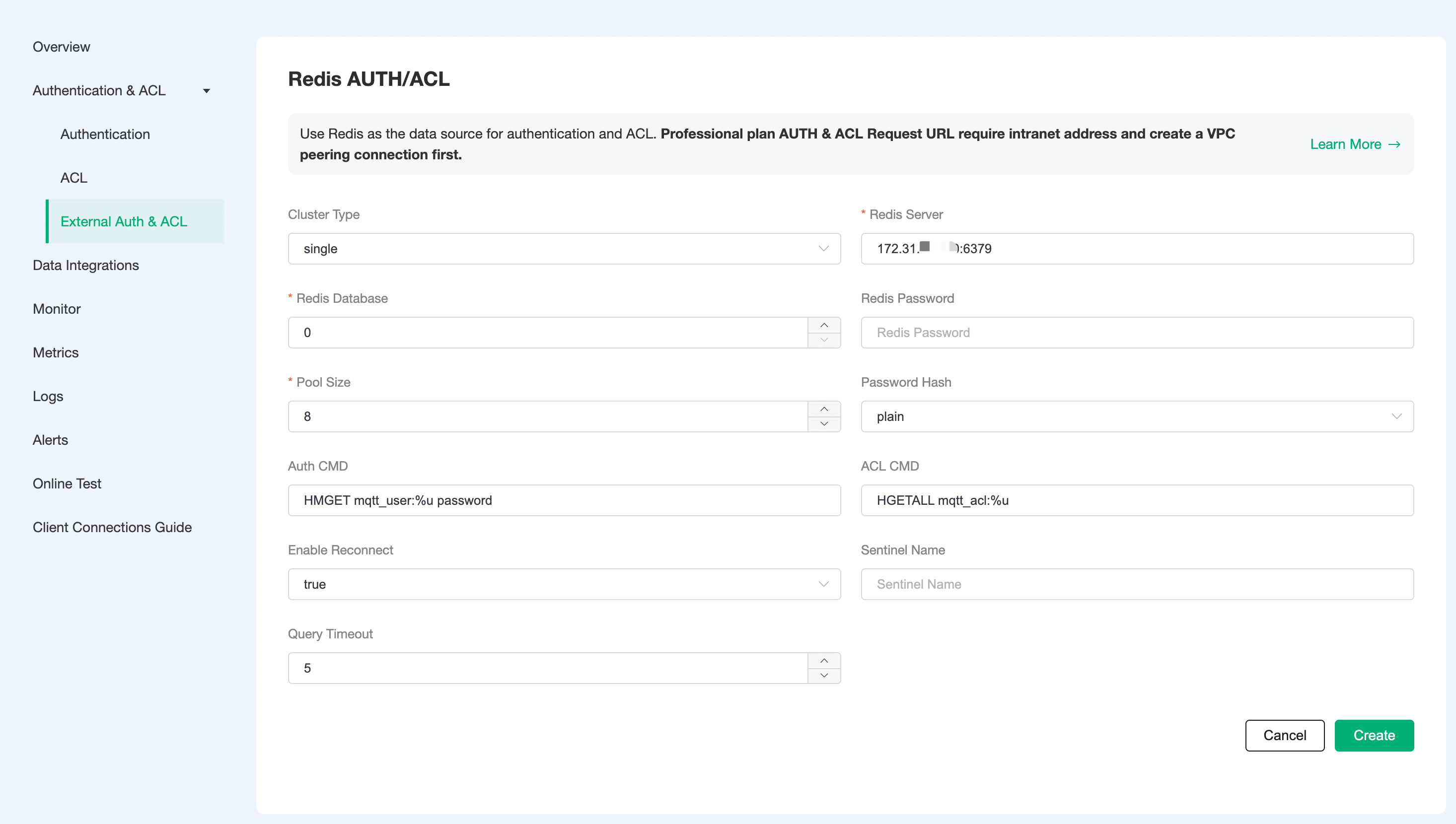Redis Authentication/Access Control
In addition to supporting the default authentication method, EMQX Cloud can also use an external Redis database as a data source to store large amounts of data and to facilitate integration with external device management systems.
Authentication Chain
If default authentication is also enabled, EMQX Cloud will chain authentication in the order of default authentication -> Redis authentication.
- Once the authentication is successful, terminate the authentication chain and the client is accessible
- Once authentication fails, terminate the authentication chain and disable client access

ACL Authentication Chain
If multiple ACL modules are enabled at the same time, EMQX Cloud will chain authentication in the order of Default Authentication Database ACL-> Redis ACL-> System Defaults (All Pub/Sub allowed).
- Once the authentication is passed, terminate the chain and allow the client to pass the authentication
- Once authentication has failed, terminate the chain and deny the client to pass authentication
- Until the last ACL module fails to authenticate, authenticate according to the System default settings --- (All Pub/Sub allowed)

Redis Configuration
In your cloud server, create a Redis service. For demonstration purposes, here is a quick build using Docker.
Pull the newest version of Redis mirror
bashdocker pull redis:latestRun Redis Container
bashdocker run -itd --name redis -p 6379:6379 redis:latest
Authentication/access control configuration
Click
Authentication Authentication-External Authentication Authorizationin the left menu bar of the EMQX Cloud deployment and select Redis Authentication/Access Control.
Click
Configure Authenticationto go to the Redis Authentication/Access Control page and fill in the information to create a new authentication.TIP
- For Basic Plan users: Please fill in the public address for the server address.
- For Professional Plan users: Please complete Peering Connection Creation first, then fill in the internal network address for the server address.
- For BYOC Plan users: Please establish a peering connection between the VPC where BYOC is deployed and the VPC where the resources are located, then fill in the internal network address for the server address.
- If you are prompted with Init resource failure! check whether the server address is correct, and whether the security group is enabled.

Since EMQX Cloud ACL is in blacklist mode by default, if you want to enable Redis ACL whitelist, you need to submit a ticket to make it work.
Permissions authentication principle
When authenticating, EMQX Cloud will use the current client information to populate and execute the user-configured authentication query command to query the client's authentication data in Redis.
HMGET mqtt_user:%u passwordThe following placeholders can be used in the authentication SQL and will be automatically populated with client information when EMQX Cloud is executed:
- %u: username
- %c: clientid
You can adapt the authentication query command to your business needs, using any Redis supported command, but in any case the authentication query command needs to satisfy the following conditions.
The first data in the query result must be the password, which is used by EMQX Cloud to match against the client password
If the salt configuration is enabled, the second data in the query result must be the salt field, which is used by EMQX Cloud as the salt value
Default data structure for permission authentication
The default configuration for Redis authentication uses a hash table to store authentication data, using mqtt_user: as the Redis key prefix, with the following data structure.
redis> hgetall mqtt_user:emqx
password publicExample data for the default configuration is as follows.
HMSET mqtt_user:emqx password publicWith Redis authentication enabled, you can connect via username: emqx, password: public.
Access control principle
When access control authentication is performed for topic subscription and publication, EMQX Cloud will use the current client information to populate and execute the user-configured access control authentication SQL, find the data related to the client from Redis, and then perform authentication.
HGETALL mqtt_acl:%uYou can use the following placeholders in the ACL query command, which will be automatically populated with client information by EMQX when executed.
- %u: username
- %c: clientid
You can adapt the ACL query command to suit your business needs, but in any case the ACL query command needs to satisfy the following conditions.
- The hash uses topic as the key and access as the value
Access control default data structure
An example of the ACL rule data format and structure is as follows.
- username: the username of the connected client
- clientid: the client id of the connecting client
- topic: the topic to subscribe/publish to
- access: allowed actions: subscribe (1), publish (2), both subscribe and publish (3)
## Format
HSET mqtt_acl:[username clientid][topic] [access]
## Structure
redis> hgetall mqtt_acl:emqx
testtopic/1 1Example data for the default configuration is as follows.
HSET mqtt_acl:emqx # 1
HSET mqtt_acl:test topic/2 2Encryption rules
Most external authentication on EMQX Cloud can be enabled with the hash method, and only the cipher text of the password is stored in the data source to ensure data security. When hashing is enabled, you can specify a salt for each client and configure the salt rules, and the password stored in the database is the cipher text processed according to the salt rules and the hashing method.
Available from: Salting rules and hashing methods
## unsalted, plaintext
plain
## No salt, hash only
sha256
## salt prefix: use sha256 to encrypt the salt + password concatenated string
salt,sha256
## salt suffix: encrypted with sha256 password + salt concatenated string
sha256,salt
## pbkdf2 with macfun iterations dklen
## macfun: md4, md5, ripemd160, sha, sha224, sha256, sha384, sha512
pbkdf2, sha256, 1000, 20